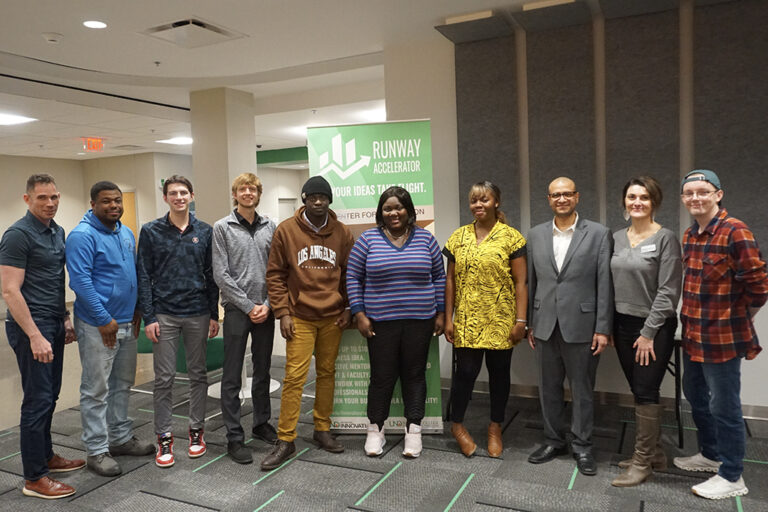‘Lay low before you go’: Video, transcript of UND Faculty & Staff Town Hall
COVID, classrooms, the community and more were discussed at Wednesday’s Faculty & Staff Town Hall
UND held an online Town Hall on Wednesday, Nov. 4, to answer questions from faculty and staff. A lightly edited transcript is below.
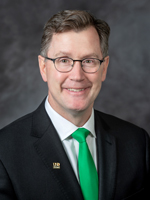
President Andy Armacost: Thanks to everybody for joining us today. It looks like we have close to 400 people here. So thanks for joining us.
The purpose of today’s session is to give you a chance to ask questions, to provide feedback and to share ideas that you have. I’m President Andy Armacost, and I’m here today with many of our senior administrators to address all of your questions and to give you good answers.
And for those items that we can’t answer today, we’ll certainly post them on our Frequently Asked Questions page on the blog.
But let me begin by taking just a quick moment to express my gratitude for all of your hard work. Faculty and staff members, you’ve really kept our mission moving forward here on campus. And so again, let me offer my thanks.
I know how tough it’s been, with all the precautions we’ve had to take to minimize the risk to you while we operate on campus. But as we continue to deliver the best possible education to our students, we are undoubtedly impacted by these restrictions.
But my hat’s off to you for making such great things happen throughout this fall semester.
Let me just remind you that it’s important for us to take these same precautions in our personal lives, too. You’ve seen the spread of COVID throughout our communities and across the state, and the rates of infection in our testing events have have been significant. So, we just encourage you to take those precautions.
And as you get ready to travel, or to consider getting together with family members over the Thanksgiving weekend, let me adopt a phrase that I heard today: “Lay low before you go.” In other words, protect yourself. Make sure that if you do take the steps of traveling, then make sure that you minimize the risk to yourselves and others so that you don’t spread the virus as you’re traveling to visit with family members.
So, “lay low before you go,” and make sure you test before you do.
All right. Other areas of interest in addition to COVID, which has been front and center on all of our minds, include just a few points.
Our Task Force for Diversity, Equity and Inclusion will begin sharing their findings with me and the Executive Council during the month of November and will have opportunities to share their great work more broadly with the campus throughout the months of November and into December.
I’m certainly eager to hear all of their ideas and to explore how we’re going to put those great ideas into practice.
In addition, we have a Task Force on the Future of Education at UND, and it’s just now started its work. We’re eager to see who volunteers and what the composition is of that particular committee.
In addition, we have two important hires going on: of course, the hiring of our new Provost and Vice President for Academic Affairs, as well as the Dean of our Odegard School of Aerospace Sciences; those are well under way.
Finally, I know there’s been a lot of attention paid to what happened yesterday, and what’s continuing to happen. But the results of the election are still unknown. And the result, of course, which we don’t know what it’s going to be, certainly has the chance to divide us as a nation.
But let me encourage each of us to take the chance to come together during this time. In our daily lives, we do something so important: we help our students transition from one stage in their lives to the next, to develop their ability to think critically and to reason and to give them the foundation for their future success.
Let’s make sure that higher purpose keeps us together, keeps our conversations about goings-on in the community respectful and appreciative of the different opinions and perspectives we have on our campus.
Let’s have that sense of togetherness dominate our words, our actions and our habits. That’s a challenge for all of us who are living in a civilized democracy. We need to make sure the lines of communication are open with those who agree with us and those who disagree with us.
So keep that in mind, please.
And now let me turn it over to Jed Shivers, our Vice President for Finance and Operations, who has dutifully served as our COVID lead over the summer and into this fall. And he’s also been an outstanding moderator for these Zoom sessions in these Town Halls. So Jed, over to you.
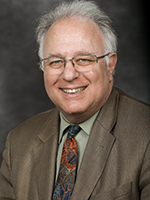
Jed Shivers, Vice President for Finance and Operations: Thanks, President Armacost. I’m Jed Shivers, Vice President for Finance and Operations and the COVID lead person for the campus, working with a really marvelous multi-disciplinary team of anywhere between 25 and 45 people. We meet Monday through Friday.
So if you recall, as we’ve done in these meetings before, we have asked people to provide us with some questions. And I’m happy to say we’ve even gotten a couple of questions already.
I really urge you to use the Q&A function in the Zoom and submit questions.
So I’m going to go through a few of the questions that we’ve already gotten; ask people to answer those, and sometimes I might answer them myself.
And then we really want to get into the questions that you all are asking of us in as close to real time as we can. And of course, as Andy mentioned, if we can’t get to a specific question during this time, we’ll be sure to answer it in the Q&A afterwards.
So never fear, we’ll make an effort to answer every question, one way or another.
And I just want to check, just for housekeeping, that a few minutes before the end of the hour, I’m probably going to turn it back to President Armacost. Does that sound like a reasonable plan?
Okay. So with that, let’s get on to some of the questions that people have asked, and please do send in those questions to the Q&A.
I think for this question, I’m going to turn to Rosy Dub, and this is something I’ve also been involved with. But I think it’s clear that vaccines are coming, the timing is somewhat uncertain. It’s probably fair to say that the initial sets of vaccine that the state gets will be given to the most vulnerable population of the state. So, you can imagine it going out to people in nursing homes and health care providers, etc.
But the question here is, what will UND’s role be? And I think Dr. Josh Wynne ought to be able to comment on this, too. What will UND’s role be in the state’s distribution of a COVID-19 vaccine? Where would UND faculty, staff and students fall in the priority queue for vaccinations?
And will UND require vaccinations for a future semester enrollment?
So, maybe Dr. Wynne, if you wouldn’t mind just thinking through the question of, what do you think the timing is for these vaccines? What’s your best guess on when they’ll become fairly widespread?
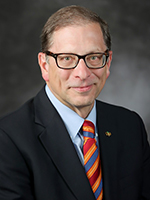
Joshua Wynne, Vice President for Health Affairs and Dean, School of Medicine & Health Sciences: Thanks very much, Jed.
Good afternoon, everyone. So, there’s been an interesting back and forth between the federal government and the vaccine manufacturers, as you may be aware, as to when they’ll be available and approved.
And if anything, there was an interesting thing where the emphasis from the pharmaceutical industry is, “We want to make sure that the vaccines are safe and effective.” And at least one prominent spokesman for the federal government was, “We got to get it out there tomorrow.”
So it was almost like that there was a flipping of positions.
As a matter of fact, there was an editorial in the New England Journal of Medicine, and the title of the article was something like, “Up is down.”
But given that, I think the realistic expectation is that around the first of the year, it’s likely or possible that vaccines will be available. The state of North Dakota is working on the distribution plan, almost literally as we speak. The highest priority is going to be for health care providers, likely followed by long-term care.
So students, faculty and staff at UND will be somewhat down the distribution list. And I think realistically, we’re talking probably about second quarter to third quarter of next year.
But this is largely going to be controlled through the state government, since that’s the way the distribution is coming from the federal government, even though manufactured by private industry.
So, that that would be my time frame based on currently available information.
Jed Shivers: Thank you very much, Dr. Wynne. Rosy, if you would just comment quickly, what role do you see the Student Health Services playing here? For example, I know Student Health Services is a primary provider of flu shots. And I should note that we did buy a nice minus-80 degree freezer to store these vaccines should they become available to us.
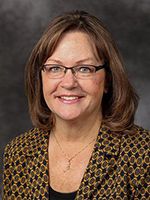
Rosy Dub, director of UND’s COVID Medical Response and Student Health Services: Student Health will be active in administering the vaccination once it’s available.
We currently are meeting with our community partners about the prioritization lists and the state’s plan that was submitted for vaccinations.
So yes, when we’re able to vaccinate, we will be out there to vaccinate. We also will be potentially assisting the community in their efforts as well.
Jed Shivers: Thank you. You know, people talk all the time about COVID fatigue, but there’s no question that this extraordinary situation that we all find ourselves in takes its toll.
So I think one question is important to address, and I’m going to ask Peggy Varberg, our AVP for Human Resources, talk about this briefly. Faculty and staff are a real risk of burning out after a long summer and fall. What kind of mental health resources are available for faculty and staff?
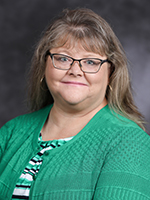
Peggy Varberg, Associate Vice President, Human Resources: Our Employee Assistance Program is always available, and there’s contact information on our website about that.
We also have a multidisciplinary group working on this particular topic to maybe offer some webinars or some roundtable discussion, hopefully one this month and one at the beginning of next month, and then more after the first of the year. This is to help us all talk about how we’re feeling and the different issues that we’re facing: COVID-related, the stress with working remotely, and additionally, with the elections and the outcome has caused a lot of stress as well. So we do have those things at work right now.
Jed Shivers: Thank you, Peggy. The next question I’d like to address is for Provost Storrs. And the question is — and we’re getting into the admissions issues for the following semester — what changes, if any, might we see in admission requirements for incoming freshmen as a result of the pandemic? Should we plan for those changes to be long-term changes? And I think we’ve actually been asked about similar questions related to the graduate schools as well.
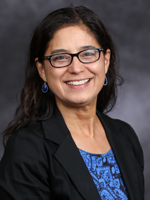
Debbie Storrs, Interim Provost and Vice President for Academic Affairs: Thanks, Jed. Hi, everyone, Debbie Storrs, Interim Provost; hope everyone’s doing well. Thank you again for your work, working with and supporting our students.
Our admissions process has changed slightly because of COVID. And we are working in coordination with the NDUS system office.
What has changed is rather than rely on a combination of ACT or test scores, standardized test scores and high-school GPA, we are admitting based on GPA alone. And this is a result of the difficulties students are having in accessing the ACT.
So we’ve been allowed to do that through summer of 2022. And we are in discussions now about whether that should continue post-summer 2022, in part because we know high school GPA is a better predictor of student academic success than standardized test scores.
In terms of the graduate admissions, those are program-specific, and some graduate programs have elected to forego GRE or other graduate standardized tests. But that’s really up to the program faculty to make those decisions.
Jed Shivers: Thanks, Debbie. I’m pretty much actually at the end of our questions that have been pre-submitted. So I’m going to combine these last two and then we’re going to move right into the questions that you’re currently submitting online.
The first question, I’m going to answer; the second question, I’m going to ask Debbie Storrs to answer. But they’re thematically similar in that they both relate to, What’s the long-term plan? How much of this which has taken place during the pandemic will we continue to see afterwards?
So the question for me is, what’s the long-term plan for students at UND regarding their campus experience, including housing, both residence halls and apartments? One gets the impression that UND is moving towards creating a University of Phoenix of the Upper Midwest. What investment toward residence halls and apartments is the campus looking at it as the future of UND?
You know, UND is really committed to the on-campus experience. One piece of evidence of that is our strong desire to remain open during this pandemic, as long as it’s feasible and safe.
Another is when one looks around the campus, one sees the burgeoning construction activity. In fact, just before this meeting, people were asking, Is there construction going on out there, because they can hear it in the background? Yes, there is, there’s quite a bit of it.
You can look at the Memorial Union. You can look at what’s happening here on the quad. You can look at what’s happening at Nistler College of Business, all of which relate to the on-campus experience.
With regard to student housing: my colleague and I, Dr. Halgren, in conjunction with the rest of the Executive Council, have been working through a plan to try and develop student housing. That includes, perhaps, some new construction and a fair amount of renovation. We are working through that right now with partners who are in the private sector in a so-called P3 model, and we’ll be continuing to work through that.
So I’d say on that one, stay tuned.
But the effort to enhance the on-campus environment really never stops, and the university is quite committed to it.
With regard to the next question, I think this is so good because they’re getting past the current time and looking into a forward direction. In responding to COVID, UND has implemented a number of new initiatives and technologies with online remote and hybrid models, as well as how we communicate with students and faculty. Are there things that UND is doing in response to the pandemic they may continue a non-pandemic environment?
I’m asking you, Debbie, if you would be kind enough to answer.
Debbie Storrs: Absolutely. I think it’s a really important question and one that we should be having conversations across departments, with department chairs and faculty, deans, etc. What lessons can we learn and glean from the pandemic that we might want to continue in the non-pandemic era, hopefully, sooner than later when we get there?
We have this Task Force that’s co-led by John Shabb and Jeff VanLooy, and that committee will be tackling with some of these questions.
But certainly, I think all of us should be asking ourselves, what do we want to continue to do?
I will say — and Madhavi Marasinghe is available as well — that we’ve invested in a lot of technology in the classroom with CARES Act spending, which we’re grateful for. And we’re actually going to enhance it even further to provide some flexibility for faculty. I think that opens up opportunities.
I think it remains to be seen, but I would encourage all of us to be part of the discussion about what should continue, what is working, what’s more effective.
As an example, University Senate had great turnout via Zoom, more so than in person. Is that something the Senate wants to continue? Some of the meetings that we have are really well attended. Maybe we want to continue these kinds of forums for better discussion and open dialogue. I’d be open to all of us considering that.
Really quickly, somebody else asked a question, and I just want to answer it in the context of this. The Task Force is soliciting nominations. This is the Task Force for the Future of Education. I asked John Shabb and Jeff VanLooy when they’re going to determine the membership, and the email I got back said at the latest by the end of November, and hopefully sooner than that, it will be announced.
Madhavi, do you want to speak to any other pieces about how the technology might be enhanced and how it can encourage us to think differently moving forward post-pandemic?
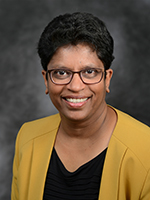
Madhavi Marasinghe, Chief Information Officer: I certainly can. We did add the microphones, the cameras and the Wacom tablets into every single one of our classrooms.
So what we are doing right now is to add ceiling mics to some of these large classrooms, because one of the complaints that we got was that the online students cannot hear what’s happening in the classroom, when there are discussions happening among students.
When we look at the improvements we are doing, I’m actually looking post-COVID as well, because there’s a very good chance that we may not go back to how we did classrooms. There will be a student or two who may want to join the classroom online. So every step that we are taking right now is looking at post-COVID as well.
Jed Shivers: Peggy, did you want to talk briefly about this with regards to staff, please?
Peggy Varberg: Yes, if I can piggyback on that, it’s a great discussion to have with staff as well. We’ve proven that this really works well in most areas. I mean, we have some positions, obviously, that can’t function off campus, but we have many that can.
This is a great opportunity for us to really review our staffing patterns and how we recruit positions and potentially offer more opportunity for folks to work remotely from different states. It’s a great recruiting perspective. And also, it’s just a great balance. Some employees really do well in this area. So I really encourage supervisors, managers, employees to have these discussions going forward outside of the COVID environments.
Jed Shivers: Thank you. Okay, why don’t we get on to the questions that people are sending us on the fly here? I’m just going to run through as many of these as I can. This first question, I’m going to turn to myself, and I think to Andy as well. And this is a question which we’ve answered in the past, but I think it’s one that actually is so important and understandable, it does deserve repetition, which is: Do you have a threshold of new cases per day in the Grand Forks area that will trigger a closure of campus?
They always say consistency is the hobgoblin of small minds. So call me small minded. But one of the things I think we’ve been quite consistent about is that the number is not really the only factor that we look at. We’re really looking at what’s going on in our community. We’re looking at our relative positivity rate compared to the community; we’re looking at whether our contact tracers are able to continue to contact tracing, because that’s, frankly, a marker of whether we have some control over what’s going on in our immediate campus community.
We’re looking at the status of the health system. And I would say that we’re getting to a point where we’re starting to feel some of the stress here. There’s just no two ways about it. No denying it. The only other thing I would add, and then I’m going to turn this question to Andy, is, I think it’s something that we evaluate all the time, and really are trying to figure out, you know, when do we do this? And what do we gain by doing it? So, Andy, if you wouldn’t mind also?
Andy Armacost: Jed, that was a great answer. And to reinforce what Jed said, that we’re always thinking about this, all the different factors, the resources that exist to respond to cases of the pandemic, or to cases of infection, the numbers. And there’s further questions in the Q&A about if the positivity rates ae 12 percent, why aren’t we shutting down post-Thanksgiving? And so forth.
As we said at the get go, we’re always evaluating this, and we’ll make what we think is the best decision for the campus that takes into account the health and safety of our members, but also the desired educational impact.
As we speak with students, we know that for many of them, their strong preference is to remain face-to-face as much as possible — to get that face-to-face experience.
Evaluation is continuous. You know, if you read the Grand Forks Herald last Friday, there was a story about the inner workings of the decision, the discussions about how we made decisions. And there was one point in August where the case load was meteoric, and we were very close to making the call to go online at that point.
I’ll be frank: two weeks ago, when the governor indicated that contact tracing was going to be shut down, and they weren’t going to do contact tracing; and we were seeing rates that were increasing — that got my attention as well. And we were on the verge of going online at that point, until we got relief from the state to allow us to continue that important contact tracing.
So we’re monitoring all the factors that Jed is is talking about. But again, principally, we’re concerned first and foremost with the health and safety of the members of the campus. And that will drive our decisions.
Jed Shivers: Thank you. A question for me. We’re already into an anxious period, and the really good question is, are we likely to experience budget cuts again in 2021?
It’s a good question. So it’s the spring of 2021, I’m thinking, that we’re talking about? Well, I’ll take the question literally, first. There’s no plan to cut the budget in the spring of 2021. If I would say that we are forced to close during that period, and we get into issues of lost revenue as a result of the pandemic, then such things are possible. But would they be budget cuts? You know, it depends on what’s going on. We would really have to look and see what sort of federal avenues are available for relief before we made decisions like that.
If you think through what happened in the fall, lots of places cut their budgets very substantially going into the semester that we’re in now, because they had to throw all kinds of money at COVID preparedness. They were posting deficits on their operating side; even Harvard University went from a $300 million profit to a $10 million loss, as reported in the New York Times. So, there were wild swings that were going on, forcing cuts.
In our case, coming into FY21, we did some budget reduction as a function of projected lower enrollment and projected lower student credit hours. So, that would be the thing that would be a trigger for me.
Going into the July — in other words, the following fiscal year — really, the question is going to be, what do our enrollment and credit hours look like, and what’s the state’s plan considering the operating budget?
Let me just get to my next question. This is one for Provost Storrs: when will the members of the Future of Academics Task Force be announced?
Debbie Storrs: I just answered that, Jed, per Jeff VanLooy and John Shabb, at the latest by the end of November and ideally, by mid-November.
Jed Shivers: Thank you. Sorry about that.
Debbie Storrs: That’s okay!
Jed Shivers: Here’s a question for Rosy or Eric. Who do we contact regarding COVID-related concerns? There seems to be no clear policy on positive cases within the university.
It’s an interesting question, because generally speaking, when people are identified as positives, they’re hooked into the contact tracer network, who in turn contact those individuals individually, who then proceeds to contact the close contacts that they’ve had. Sorry, but that’s literally what it is.
I should point out that because my name is on a website, I get many queries as well. And we field them to various people around the university as appropriate. So I’m hoping that there’s not too much confusion about this, but if anybody here and particularly Rosy and Eric would like to elucidate further, that’d be great.
Rosy Dub: This is Rosy, and I’m the clinical director of response for COVID. I would like to make sure that people know about our COVID blog on our website. There is a dashboard that is public facing for you to see our positivity rate; all of that information is out there. If you haven’t looked at that, please do so.
There’s also, I think, a question coming up about Q&A. And that is also on the UND blog. If you scroll through the different areas of blog, you’ll find sections that have questions and answers that are relevant to our workplace and our presence on campus.
If you have specific questions, I’d encourage you to approach your supervisor, I have contacted our HR department for our department frequently on different things. As Jed mentioned, emails come directly to him, they come to me, David Dodds receives some from UND Info. Those are avenues that you can access also for your questions.
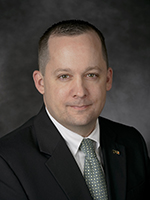
Eric Plummer, Associate Vice President for Public Safety and Chief of Police: And really, if you have a question about if someone’s positive, or if you’re positive and need assistance, or if you’re working through filling out the online reporting form, or you want to know, what does that mean for your office environment? Who provides extra cleaning? You can always call the Office of Safety. And we will walk you through that process and line up the cleaning, specifically for that area, through facilities.
Jed Shivers: This is a question around travel, and I’m going to direct this question to a combination of Josh Wynne and Debbie Storrs and Andy Armacost. I think this question is about Thanksgiving, which is why I mentioned it. With North Dakota positive test rates exceeding 12 percent since Halloween, why is it considered safe for people to travel home and then travel back to UND over holiday, when they’ll only be back for a couple of weeks before they’ll travel home again for the Christmas break? First question would be what is the policy concerning students, for example? Then what’s the policy for faculty and staff?
Debbie Storrs: I’ll tackle a piece of this, because I think there are multiple questions embedded in here. There are no restrictions on either staff, faculty, student or anybody’s travel during the holiday for personal reasons. We’re certainly encouraging students to test before they go home, so that they are informed about their health status. Then similarly to President Armacost’s point, to be careful, to be cautious and to take into consideration the situation across the state and beyond, if you do choose to travel. So those are the pieces I can answer, but there are maybe some larger questions about “Is it safe?” I think we’ve all seen the numbers across the U.S., and I’ll let Dr. Wynne speak to that, and that’s why we’re continuing to require the mask coverings, the distancing and the hand-washing, etc., while people are on campus.
President Armacost: Before Josh speaks, Debbie, let me address the premise of the question: is it safe to travel? As we’re monitoring the percentage of positivity we’re seeing a trend. The positive rates for students tracked closely to the positivity rates for the local community. Then, about two weeks ago, the positivity rates for our students started decreasing. What we are seeing is that in at least the last three mass testing events – our student positivity rates are actually lower than the rates in the local community. Then, beginning on Saturday, our positivity rates took a turn to go the other direction, and we’re closely monitoring all those positivity rates. There is a lot of data out there about what will guide our decision about what is safest for the campus, and what’s safest for its members. Thus, our recommendations for the remaining portion of the semester will depend upon the conditions of the pandemic. You’re right, there isn’t a rosy picture out there, as one person had indicated in their post on the Q&A board.
Jed Shivers: Thanks, Karen. I actually understood that, which means you did a great job. Now, let me turn this over to President Armacost for last few words as the hour closes.
President Armacost: Thanks, Jed. I appreciate all the great comments and answers that this great team has given to the viewers. To have each of these senior administrators gather together to give you the information you need is a great indication of the level of commitment to your health and safety. Once again, thanks for everything. Let me encourage everyone to follow our prevention tips and continue to get tested.
Jed Shivers: If you had any trouble hearing that we’ll provide a transcript later.
Jed Shivers: Josh, do you want to comment briefly on what we think this question is about?
Joshua Wynne: Notice that Jed emphasized the word “briefly,” and I’ll try to follow that part of the question. You’re supposed to laugh at that. We know that especially in the Midwest that a lot of the uptick is related to small gatherings, not large gatherings. Based on that, I would say from the medical – not a UND standpoint, but a medical standpoint – that I am very concerned about Thanksgiving. Not simply the travel, but the congregation of families getting together. That is a recipe for further spread. What my wife and I have decided, on a personal level, is that much to our disappointment, we are not going to be having a Thanksgiving dinner with our extended families. We’re just not doing it. I think that’s for all of us to determine, but the medical advice would be to be very careful about gatherings, particularly if one is not able to or one chooses not to do what Provost Storrs suggested, which is to get tested right before. Getting tested right before is no guarantee, but it does suggest in the short run that you might not be infectious. You still could have COVID, and you may be become infectious hours or days after that negative test, but that would be reassuring. But otherwise, I think each of us has to ask real questions about whether this is the Thanksgiving to travel and get together with our families, sad to say.
Jed Shivers: I hope that answered the question. As we noted, it was multi-pronged, and I appreciate everyone participating and doing their best to answer. Let’s go back to our academic environment. This is a question both for Debbie Storrs and Madhavi. Some students have had sporadic and sometimes frequent internet connection issues and aren’t receiving emails or aware that an assignment is due until it is too late. Is there any grace period if this happens, so that it doesn’t hurt their grades?
Madhavi Marasinghe: If the issues are within the UND network, meaning if they are on campus or in the residence halls, do ask the students to go ahead and talk to the head desk. That way we can see what’s going on and resolve it. If they are in quarantine/isolation in one of the UND-designated hotels, they can speak to the front desk at the hotel. If they are unable to do that, do ask them to drop a note to me or even the head desk. We contact the owners of the hotels and deal directly with them to make sure the network is up to par, so they can get their work done. If they are other places, home, somewhere away from service that we provide – if they continue to have issues, let’s see what we can do so they can get their work done.
Debbie Storrs: Thanks Madhavi. The only other thing I would say is to thank the faculty for their flexibility to the students when they are encountering such tech issues. So I appreciate that. The other piece is that we’ve worked really hard using CARES dollars to allocate laptops for students who qualify for them, and we’re almost done with that distribution. We have 300 more laptops to distribute. Our Admissions, our Enrollment Management and Madhavi’s team are doing that. Again, it’s really up to faculty to try to work with the students, and I appreciate those efforts.
Jed Shivers: Another quick one for Debbie, since we’re on the topic of activities of daily living, teaching and learning. We have had an immense number of students asking for S/U grading. If we’re going to transition to the policy we had last semester, will there be a decision or messaging to students announcing this policy will not be changed?
Debbie Storrs: As you might know, the Student Senate passed a resolution requesting the same kind of modifications to the S/U grading policy that we implemented last year. We have an existing S/U policy, but they want the same sort of flexibility we provided last spring. That is up for discussion at University Senate this Thursday. So we want that discussion to happen, to see what kind of questions and support we might get from Senate before final decisions are made.
Jed Shivers: Quick question for Vice President Halgren. I haven’t received any notifications from OSRR regarding positive students, although I know I have positive students because they have emailed me. Has the process changed, or are students not opting to have OSRR email faculty anymore?
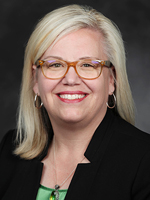
Cara Halgren, Vice President for Student Affairs & Diversity: That’s a great question. I would have two responses to that. First, the process hasn’t changed at all. Information is still coming from OSRR. I think you may be right – students are getting tested in other places, so students may not be sharing that information with the University. If you hear from students that they are positive, I would encourage you to remind them that OSRR would love to be able to support them while they are positive, and the best way to do that is for them to submit their information through the Veoci forms so that OSRR can be in contact with them. If you have specific questions about your particular class/classes, I would ask that you contact OSRR directly and Dr. Alex Pokornowski, just to make sure that there hasn’t been a gap somewhere and something hasn’t been missed.
Jed Shivers: This is a question for probably Rosy Dub, but others can chime in as well. The North Dakota Department of Health has suspended or significantly delayed any contact tracing for anybody showing up COVID-positive, limiting the effectiveness of folks that are non-symptomatic but contagious. Students are being told to contact close contacts – not as exact science as creating quarantine efforts for close contacts who aren’t really close contacts. Is close-contact-tracing really occurring at this point? I’m turning this over to Rosy, and it’s important to note the UND community is actually different from what’s going on with the rest of the state. That’s why we secured a contract with the state’s Department of Health to have our own contact tracers.
Rosy Dub: I’d like to go back to stress the point that the North Dakota Department of Health hasn’t discontinued contact tracing. They still do inform every positive case of their positive status. What they’re doing is asking that positive case to go forward and identify their close contacts, providing them educational materials and assistance in identifying who would be a positive contact, and what to supply them for information.
That all came about because of the huge number of positive cases that North Dakota has experienced. It basically has overloaded any system that can reach out and individually contact each close contact. If I am a positive case, the state is going to call me and they’re going to ask me about who I’ve been near, who I’ve been with, that meets the criteria of close contact. Those persons are included in my case investigation, but they do not go and call those people. It would be up to me to do that. They still are identifying close contacts, but they’re not the ones who are reaching out to them.
When Jed mentioned that our University team is maintaining its past practice in what the state’s Health Department was doing, we are continuing to do that practice. Our contact tracers, when we receive a notification of a positive student, will reach out to the student for the case investigation. We will also reach out to the close contacts to provide them information. They may not have a separate file in the state system as we are used to in the past, but our response has not changed. We’re still reaching out to close contacts. It was a practice that was changed in response to the huge number of positives in our state. Unfortunately, we have widespread community spread now.
Contact tracing is valuable to us and our campus, our individual community, but it has lost some of its effectiveness in the greater community, because we are no longer able to necessarily go back and identify the source of the infection, because it is so widespread. So it’s still extremely valuable. I don’t mean to sound like it isn’t, but we have passed some of those stages of mitigation, and now we’re in the mode of suppression. So some of our actions changed with that. In addition to contact tracing, UND is in the process of assisting other campuses in North Dakota with contact tracing as well.
Joshua Wynne: I might just add to the very nice explanation by Rosy that, in discussions with the Department of Health, this is not necessarily a permanent decision. As Rosy suggests, once we start getting on the other side of the curve and reduce the amount of community spread, then contact tracing will be much more effective. Hopefully with the number of positives going down – at some point in the future – those resources will then become really valuable to restart aggressive contact tracing. It’s not felt that this is an all or none or permanent decision. The Department of Health earnestly wants us to get into a position – “us” being North Dakota – to get into a position where it can be reinstituted at some point in the future.
Rosy Dub: What was described to me was that we want to make the most effective use of our resources. And right now, that’s what we have to do until we can get this under control and then, as Dr. Wynne stressed, resuming contact tracing to the height that it was.
Jed Shivers: Here is an interesting question that is thematically different than what we’ve discussed before, but certainly timely, and it relates to the recent executive order that was issued by the Office of the President of the United States – to change the emphasis that is being placed on training related to, as it says in this question, race and sex stereotyping. The question is about essential academic freedom. What is the University’s position on academic freedom as it relates to this executive order? For this I’m going to turn to both Andy and Debbie Storrs.
Debbie Storrs: I’ll say a few words, then turn it over to the president. Both the president and I are supporters of our academic freedom when it comes to diversity and inclusion and all topics. It’s essential that faculty have the support and the comfort in continuing to help educate our students on these really important issues. That remains a real focus for us, and in our interpretation and understanding informed by Donna Smith, who is our EOC officer here at UND, we have every right to continue to provide that education to students. Please know both the president and I are supportive of your efforts. Andy, do you want to speak to some of the other pieces? We continue to monitor the interpretation of this executive order, and currently there is a lot of ambiguity. But the protection of academic freedom in the classroom seems to be one that it doesn’t touch on, in our understanding. And we want to protect that.
President Armacost: Great comments, Debbie, and we’re monitoring, as Debbie said, what our professional societies and professional organizations and our academic consultants are finding and learning throughout the evaluation of this new executive order. We’ll take all those inputs and make good decisions, but academic freedom is something essential to every university. As Provost Storrs said, we stand by those principles.
Jed Shivers: Moving on to sort of a budgetary item here. We’ve gotten a question. Is UND considering a buyout program this year, VSIP (Voluntary Separation Incentive Program) as we call them? And if so, when will the information be announced?
As you probably know, this has been something that we’ve been doing annually almost, I would say; certainly, since the time that I’ve been here, and I started in May of 2018, whether or not there’s a budgetary imperative to do it. I think the answer is that we’re considering doing this. Probably we’ll be talking about it at an upcoming Executive Council meeting and whatever the outcome of that decision is, we’ll be going from there.
Jed Shivers: Another question on the Thanksgiving issue, which is clearly front of mind. Some students are not planning to return after Thanksgiving, forcing instructors to accommodate hybrid classes for those who would prefer in-class instruction. Many schools going to online-only classes are impacting other schools’ instruction delivery. Will this continue to be a disparate or will there be a standardized university policy? If yes, when will the decision be made?
Debbie Storrs: If I understand the question, the decision has already been made, that we’re going to continue in our current process post-Thanksgiving. So we’re giving faculty the flexibility in how they’re going to deliver their courses. We’re going to continue to offer them both online and hybrid. It’s really a faculty decision on how they’re going to offer those courses. And hopefully, you could accommodate a student. But really, if the class is hybrid, and it’s scheduled to have rotating students in and out, students should plan on attending. Karyn, do you have any other comments? Any requests on the part of students?
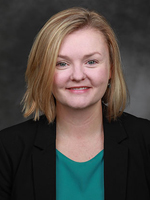
Karyn Plumm, Vice Provost for Student Success: I have heard from a lot of advisors that students are asking what their options are. The feedback advisors have been giving is to talk to your instructors, talk to your faculty members about how classes are going to be offered. Any accommodation that’s made outside of an illness is up to the faculty member.
Debbie Storrs: I will say that I have heard from many, many students and from faculty that they are trying to be as flexible as possible. Again, we want students to be as comfortable as possible in how they’re getting the courses, but it is up to the faculty member. President Armacost, do you have anything you want to add to that?
President Armacost: Just one quick thing and that is: a lot of factors go into the determination of if we go online. We talked about some of the resource constraints and the trends with respect to infections. But our ability to deliver and our ability for individual faculty members to effectively deliver their classes is an important component of this. So if you could provide more information up through your department chairs, the deans and up to Provost Storrs about the specific instance here, just so we can understand how broad this impact is or if it’s relatively local, that will help us make good decisions as we figure out how to navigate the rest of the semester.
Jed Shivers: Not surprisingly, Rosy’s good explanation of what’s going on with contact tracing and mitigation versus suppression has generated lots of additional questions. So it’s probably worth spending a minute or two on these. And I’m going to ask this first of Dr. Wynne and then of Rosy. The question is: can additional explanation be given for the difference between mitigation and suppression? What actions, processes may be different between the two, and how does that impact UND’s decisions?
Rosy Dub: I can start with my non-epidemiology education. But what I’ve been taught from epidemiology is that basically when you have greater than 10 percent community positivity rate in transmission, you move from what we call mitigation to suppression. We have set up all these practices to reduce the risk of spreading COVID, which is still important. But, we have broken through a lot of those barriers, it is now all over the community. So, now what can we do to minimize the effects of that widespread infection? To me, it’s like holding my finger in the dam, and I’m trying to hold it back, and so much has leaked, and now what can we do to prevent it from getting even worse? What else can we do to protect the health and safety of our community? Dr. Wynne, do you have more to add to that?
Joshua Wynne: Without doing a public health epidemiology lecture, which I’m sure will put everyone to sleep, I’m not going to focus on terms, I’m going to focus on two concepts. The concept that we used initially was to do widespread testing, contact identification and then quarantining of contacts. That approach, if you can do it in a widespread manner and aggressively, we hope will prevent what we call community spread. That’s why we push so hard to have widespread testing, because widespread testing is the cornerstone of doing that. But even at present with all of the testing we’ve done for the entire University System, since the start of the pandemic, we’ve only tested roughly 40 percent of the student population. I may be off a little bit. It would have been far better had we been able to do it, to be able to test every student, and do it repetitively.
And then, what happens when we got beyond that phase, when there is, as Rosy said, widespread community spread? What we need to do now is not simply to rely on widespread testing and contact tracing, because that’s not enough at this point to really bend the curve. That works early but if unsuccessful, as it’s become, then really the only tools that we have are to try to prevent the spread. And, that means four basic things that you’ve heard us say over and over and over again. Wash your hands, watch your distance, wear a mask, and limit the number of contacts you have with other people. Those are really the four key things we need to do now to get this back down to a level where we can go back to effective identification of people, contact tracing, and so forth. That will help us when we get on the other side of this. But, since cases continue to go up, we need to do those four things as aggressively as we can because we cannot test our way out of this once we reach this phase. Then, the personal choices that we make are going to be the only way we can start bringing the numbers down until we get more effective treatments and vaccine. And, that’s unlikely to be before next year.
Jed Shivers: Just to echo this little tiny bit, we’re really in a place where our behavior, both individually and collectively, is going to drive the bus on bending the curve. And, if there’s an important takeaway message from where we are right now, that’s the takeaway message. With that sort of tough sounding part, I think it’s very important to turn our attention to hockey. And the next question is: since the hockey team is going to be in the bubble in Omaha from Thanksgiving through finals, will faculty be required to accommodate them? So this actually is not a Bill Chaves question. I think this is more of a Debbie Storrs question. Is that right?
Debbie Storrs: I’m happy to respond to part of it. But I would appreciate Bill’s comments as well in terms of how much time this will require of students playing hockey. So yes, faculty are asked to accommodate to students who are in sports activities. And so we hope that you would accommodate this particular request. In my understanding – Bill, please correct me if I’m wrong – this is actually fewer days than in a typical semester pre-COVID that we would accommodate students who are off campus to play hockey. Students who are on the team and playing will also have access to internet, so they should be able to access some of their schoolwork. And so maybe, Bill, you could speak more specifically to how many days, for example, that faculty will have to accommodate.
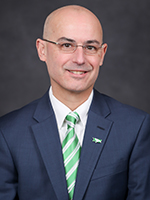
Bill Chaves, Athletic Director: Thanks, Provost Storrs. Welcome, everybody. We don’t even have the schedule yet for the games at this point. But, the one thing that was crystal clear when the presidents discussed this was that all of the eight schools that are going to go to Omaha were going to be into the finals to some degree. So for sure, our games are going to be limited during that timeframe. Once we get the schedule, no different than any of our other student athletes, they will work with their professors and make sure that they know exactly what their schedule is at this point in time. So, more to come but Debbie is right. Because we haven’t played sports here this semester, all of our student athletes have been here in Grand Forks. At the end of the day, the missed classes have been certainly at zero at this point in time. So knock on wood, we’ll see if this occurs or not, but certainly it’s in play for us to continue to discuss this, knowing where we are from the COVID standpoint.
Jed Shivers: We’ve got about three minutes left of our hour. I have one 30-second question for Dr. Plumm. And that is: when do we schedule a final during finals week for an asynchronous class?
Karyn Plumm: I don’t think asynchronous courses are part of the finals week schedule posted on the Registrar’s page. So those can be scheduled around students. We would ask that there’s some flexibility, not choosing one day at one time, because some students may have other courses that are not asynchronous that would conflict with that, and that would cause a problem for them. We are recommending just a little bit of flexibility in terms of when they can choose to take that final during finals week. That typically works for an asynchronous course. If students do have a conflict, they are asked to talk to their instructor about that conflict and make an accommodation for that.
Jared Shivers: Thanks, Karen. I actually understood that, which means you did a great job. Now, let me turn this over to President Armacost for last few words as the hour closes.
President Armacost: Thanks, Jed. And I appreciate all the great comments and answers that this great team has given to the viewers. Once again, thanks for everything.
Jed Shivers: If you had any trouble hearing that we’ll provide a transcript later.
Additional questions and answers
Following are additional questions and answers that were not able to be answered during the live event.
Has there been an discussion of extending the leave policies that require staff to take 40 hours of PTO for the year and only carrying over 240 hours, since many of us had our summer (and other) vacations canceled in 2020?
There will be no change in the 240 carryover, but there is discussion at the Chancellor’s Cabinet level regarding the 40 hour minimum. Hoping to have an answer on that next week.
Can we admit and provide assistantship to international students with TOEFL or IELTS scores?
Yes, we can admit with TOEFL or IELTS scores; both meet our English proficiency requirements as long as students meet our score minimums and all other admission criteria. As long as the student meets the minimum scores required, they can be offered an assistantship. If the student is at a distance due to not being able to travel to campus, this would need to be approved by the School of Graduate Studies and the HR/Payroll office to make sure that the student is able to work from their current location.
We have had an immense number of students asking for S/U grading and if we were going to transition to the policy we had last semester. Will there be a decision or messaging to students announcing this policy will not be changed??
Student senate has a resolution about S/U grading and this is a topic of discussion for University Senate this Thursday. Thus, at this point, no decisions have been made.
How are staff responsibilities being evaluated while they are working remotely? There are some staff across campus whose main role is to serve faculty, staff, and students, and if they are remote the need for this is different. In some cases departments don’t want to reduce employee hours in fear of losing that position in the future.
Staff who work remotely should be submitting productivity reports to their direct supervisor. This helps to assess the work that is continuing to occur.
Will professors have the option to move finals to another date outside of finals week?
No, please do not move your finals to another date to prevent student conflicts of multiple tests and to avoid adding stress to students. Thanks for asking.
